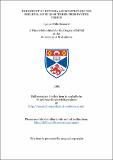Files in this item
The effect of hypoxia acclimation on the skeletal muscle of three freshwater fishes
Item metadata
| dc.contributor.advisor | Johnston, Ian A. | |
| dc.contributor.author | Bernard, Lynne Mills | |
| dc.coverage.spatial | 200 p. | en_US |
| dc.date.accessioned | 2018-07-04T15:21:18Z | |
| dc.date.available | 2018-07-04T15:21:18Z | |
| dc.date.issued | 1985 | |
| dc.identifier.uri | https://hdl.handle.net/10023/14932 | |
| dc.description.abstract | Many species of fish may be exposed to hypoxia in their natural habitats, either on a temporary or a more permanent basis. The survival of the animal may then be dependent on its ability to adapt to the conditions imposed upon it. There are several known ways in which a fish may adapt itself to coping with reduced oxygen levels such as by alterations in respiratory and ventilatory capacities and by changes in the oxygen carrying capacity of the blood. This study examines the effects of acclimation to hypoxia on the oxygen consumption, muscle ultrastructure and capillarisation of three species of freshwater fishes. The species studied could all expect to experience hypoxia in their natural environments. The tench, Tinea tinca, would very probably become hypoxic during its winter hibernation buried in the mud at the bottom of ponds and rivers. The Crucian carp, Carassius carassius, inhabits sluggish or still waters where rotting vegetation reduces oxygen levels and it often spends its winters under complete or near complete anoxia in ice-locked ponds. In terms of muscle ultrastructure and capillary supply, three very different responses to hypoxia acclimation have been found in the three species under study. Considering only the parameters studied the following hypothesis are proposed to explain the changes observed. Previous studies suggest that the increases in oxygen consumption observed after acclimation to hypoxia are due in part to increases in the oxygen affinity of the haemoglobin caused by decreases in the concentrations of the red cell nucleoside triphosphates. The decreases in mitochondrial volume density and capillary supply in tench muscle after acclimation to hypoxia could be due to a reduced level of spontaneous locomotory activity. Tench experience hypoxia mainly during their hibernation period where they remain totally quiescent. Energy requirement would be very low and metabolic rate would drop so some of the mitochondria and capillaries not required might be degraded. The Crucian carp show a marked increase in volume density of mitochondria, especially in the slow muscles, after acclimation to hypoxia however capillary supply is little affected. This may represent an adaptation to increase the utilisation of circulating oxygen stores. The increased mitochondrial volume density would increase the extraction of oxygen from the blood thus decreasing the PO2 of the venous blood which would facilitate an increase in the rate of oxygen transfer across the gills. The mitochondrial volume densities and muscle capillary supply were unchanged in the air breathing catfish after acclimation to hypoxia. In this species it is likely that the increased ventilation of the suprabranchial respiratory organs together with the increased oxygen extraction at the gills obviated the need for significant changes in these parameters. These studies have considered only a few of the possible adaptations which might occur in response to acclimation to hypoxia. There are many other factors such as the effects of the concentrations of the nucleoside triphosphates which would have to be studied before these hypotheses could be verified, thus there is much scope for further study on the subject of hypoxia acclimation in fish. | en_US |
| dc.language.iso | en | en_US |
| dc.publisher | University of St Andrews | |
| dc.subject.lcc | QL633.B3 | en |
| dc.subject.lcsh | Freshwater fishes | en |
| dc.title | The effect of hypoxia acclimation on the skeletal muscle of three freshwater fishes | en_US |
| dc.type | Thesis | en_US |
| dc.contributor.sponsor | Natural Environment Research Council (NERC) | en_US |
| dc.type.qualificationlevel | Masters | en_US |
| dc.type.qualificationname | MPhil Master of Philosophy | en_US |
| dc.publisher.institution | The University of St Andrews | en_US |
This item appears in the following Collection(s)
Items in the St Andrews Research Repository are protected by copyright, with all rights reserved, unless otherwise indicated.

